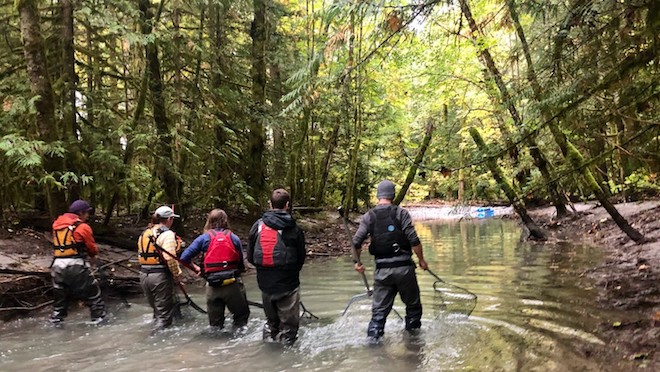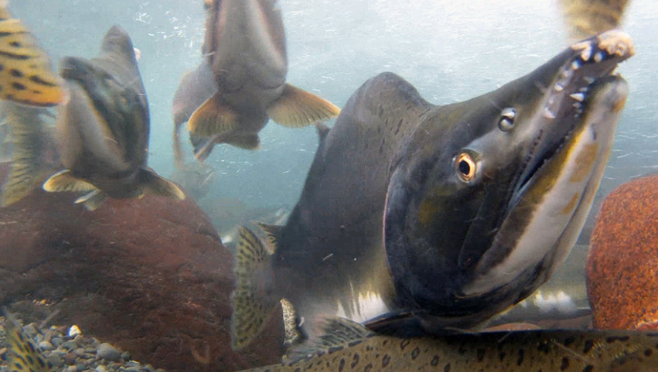 Our crews monitor spawning pink salmon in shallow channels on the Cheakamus River near Squamish.
Our crews monitor spawning pink salmon in shallow channels on the Cheakamus River near Squamish.
Massive 2025 run of smallest salmon species in focus for anglers, BC Hydro
This could be a record year for the Fraser River pink salmon migration in B.C., with 29 million fish estimated to enter the Fraser River system this August and September, along with huge numbers also expected to return to the Cheakamus River near Squamish.
It's an odd-year natural wonder –the major pink runs in the area happen on odd years, including 2025 – for the smallest and least appreciated salmon species. But just because pink salmon are unlikely to be featured on the menu of your local restaurant doesn't mean they aren't delicious. And just because they rarely grow above five pounds doesn't mean they're not prized by anglers or by those in the business of preserving fish habitat.
When the pink salmon spawn and die in the Cheakamus River, they not only leave fertilized eggs in the river bottom to keep the river-to-ocean-to-river cycle going, they're also a vital protein-rich nutrient for eagles and other wildlife.
"Pinks are the biggest contributor to the overall health of the river system," says Clint Goyette, a Squamish-area fishing guide and fervent advocate for pink survival enhancement on the Cheakamus. "Beyond the fact that as anglers we get to fish for adult pinks, the overall biomass they bring back from the ocean helps everything from bull trout and resident rainbow trout and cutthroat to eagles, bears, and other wildlife."
We work closely with stakeholders on an operations plan
Goyette is among the many stakeholders, who have helped BC Hydro develop a Cheakamus Operations Plan that has evolved significantly in recent years. The Squamish Nation also played an important role in developing this plan. As climate change increases the chances of major fall rainstorms arriving earlier (and with more rainfall) than in the past, we've fine-tuned the way we manage flows in the river.
If there are no big rainstorms during the pink spawning season – roughly mid-August into October – the pinks will likely go about their business of egg-laying without issue. But if big rains hit, some pinks could be stranded after water recedes and shallow, temporary channels dry up.
We're doing everything we can to avoid that scenario. We're getting better at monitoring the salmon, tweaking flow reductions known as "rampdowns" on the Cheakamus, and regularly updating the local community, Squamish Nation, and anglers on the river.
"We've seen dramatic improvement in what BC Hydro's operations are doing on the river," says Goyette. "There's always room for improvement, but we're all learning as we go, including our understanding of how the fish behave in this changing climate."
By March or April of 2026, millions of eggs from this fall's run will hatch, with the salmon fry moving downstream, first to the estuary at the mouth of the Squamish River, and then out to the open ocean, where they'll grow to between two and five pounds and return to spawn in the Cheakamus in 2027.
"It's exciting because it's very easy for people to catch them, and you can see them in the water," says Goyette. "It also coincides with vacation time and summer. With a lot of the other salmon returns, it's pretty miserable weather –it can be hard to convince somebody to stand out in two-degree weather in the driving rain."
 When pink salmon return from the ocean to spawn, the males morph into “humpies”, distinct from female salmon for their humped backs. (Photo courtesy fisheries.noaa.gov)
When pink salmon return from the ocean to spawn, the males morph into “humpies”, distinct from female salmon for their humped backs. (Photo courtesy fisheries.noaa.gov)
Water flow 'ramp downs' aim to mimic natural flow of the river
Low water can cause stranding of fish, and so can large or sudden changes in water levels. Four years ago, pinks were stranded in pools on the Cheakamus after water levels dropped following a major storm in early fall.
Both the exact number of pink salmon returning to the Cheakamus, and the weather during spawning season, are difficult to predict. But we have the ability to control water levels on the Cheakamus River at Daisy Lake Dam, which holds water flowing south in the Cheakamus River to create Daisy Lake Reservoir. The river is fed by glacier melt and other inflows to the system, and controlling river levels south of the dam can give salmon on the river an advantage over those on wild rivers hit by drought.
Here are a few key things we're doing to protect pink salmon on the river:
- Conducting weekly raft patrols to monitor conditions and identify potential stranding risks early.
- Adding more crews and resources to the area during peak migration and salvage periods.
- Closely coordinating efforts with the Squamish Nation.
- Monitoring and adjusting river flow levels to support fish passage.
"Our operators try to mimic flows in a natural storm hydrograph – what the projected natural inflows would be without the dam – so that the peak and tail are what occurs in a natural rainfall event," says Taylor Ward, a natural resources specialist with BC Hydro. "Our operators are pretty good at mimicking the timing and the shape of that natural curve."
Since the Cheakamus Adaptive Stranding Protocol (CASP) Committee was formed in 2018, we've deepened our knowledge of the river through comprehensive monitoring, data analysis, and ongoing collaboration with the Squamish Nation, regulators, and stakeholders. Each year, we typically begin reducing flows in August through a gradual 10-day ramp down, based on real-time conditions. This timing reflects the end of freshet and a transition from higher recreational flows, helping us preserve water supply into late summer while supporting critical fish habitat.
While some fish stranding remains an unfortunate reality, particularly during storm-driven inflows and extreme weather events like atmospheric rivers, we continue to implement and refine mitigation strategies to minimize impacts wherever possible. The anticipated record-breaking return of pink salmon in 2025 adds complexity while presenting an opportunity to learn and adapt.
"The number and the duration of storms in the early fall has increased," says Edgar Lazarte, operations planning engineer for the Cheakamus River system. "Atmospheric river events are getting more common, and we might have back-to-back storms in a very short period of time."
It's also another summer of drought in many areas of B.C. And while the issue of stranding fish on the Cheakamus is related to storm flows, we need to store water in the reservoir to continue to meet minimum flow levels downstream in late August and September.
"This is a continuous balancing act for dam operators through the late summer and fall," says Ward. "Storing water to maintain minimum flows during droughts while leaving sufficient reservoir storage available to absorb incoming storm flows at the beginning of the fall season."
Daisy Lake Reservoir stores water to power 96,000 homes
For decades, the Cheakamus generating station has been providing British Columbians with enough renewable electricity to power the equivalent of 96,000 homes per year.
Located 40 km north of Squamish on the unceded traditional territory of the Squamish Nation, Tseil-Watuth Nation, and Lil'wat Nation, the Daisy Lake Dam impounds water flowing south in the Cheakamus River creating Daisy Lake Reservoir. The water in Daisy Lake Reservoir takes one of two paths to the Squamish River. It's either released from the dam down a 26-km stretch of the Cheakamus River to its confluence with the Squamish River, or it's diverted through a tunnel that runs through Cloudburst Mountain to the Cheakamus Generating Station on the Squamish River.
BC Hydro operates the dam, its discharge facilities, and the generating station in accordance with its water licences and the 2006 Water Use Plan Order, which sets guidelines for balancing power generation, fish flows and flood protection, as well as recreation. Daisy Lake is a relatively small reservoir for the inflows it can see during heavy rainfall events, meaning storm events will result in large fluctuating flows on the Cheakamus River.
The 2006 Water Plan Order is currently under review and involves many of the same participants as the CASP committee, including the Squamish Nation, and stakeholders including Government of BC, Department of Fisheries and Oceans, and recreation and angling interest groups. The review will apply learnings from 10 years of monitoring studies on the Cheakamus River and, once completed, will recommend an amendment to the Water Use Plan Order that will likely include updated flow-ramping rates, higher minimum flow thresholds and other strategies to protect fish and deal with drought conditions on the river.
For now, we're preparing for the potential of early fall storms and how best to protect fish on the Cheakamus.